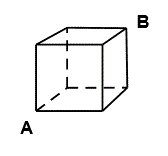| Problem |
Solution |
3) The area of a rectangle is 48 square feet. The lengths of the sides are whole numbers of feet. What is the largest perimeter the rectangle can have?
|
Make a table (L is the length and W is the width):
| L | W | Perimeter | Area |
| 1 | 48 | 98 | 48 |
| 2 | 24 | 52 | 48 |
| 3 | 16 | 38 | 48 |
| 4 | 12 | 32 | 48 |
| 6 | 8 | 28 | 48 |
Find the combination of length and width that results in the largest perimeter = 1 x 48 = 98 ft. .
|
4) Ace, Berrit, and Calynn have a loop of string that measures 12 feet around. They each hold it with one hand and pull it taut to make a scalene triangle (none of the sides have the same length). After experimenting with different triangles they realize there is a range of values for the longest side. What are the low and high numbers for the range? Express your answer using inequalities with L representing the length of the longest side.
|
1. If Ace and Berrit stretch the string taut with Calynn not holding it, the doubled string length is 6 feet.
2. Suppose Calynn holds the string in the middle and makes an equilateral triangle 4 feet on a side. This is not scalene, but if she moves even an inch to one side, then she has created a triangle with these sides:
- 3 ft 11 inches
- 4 ft 1 inch
- 4 ft
3. From these two pieces of information you should be able to determine the low and high numbers for the longest side.
4. The longest side must be more than 4 feet and less than 6 feet. The inequality is:
4 ft < L < 6 ft.
|
5) The length of the shortest trip from A to B, along the edges of the cube, is 3 edge lengths. How many different 3-edge trips are there from A to B?

|
1. From A how many paths can you take? 3
2. After you have taken one of these paths, how many can you take from there, assuming you don't go backward? 2
3. From that second point, how many ways are there to get to point B? 1
4. Multiply these together to get the total number of paths =
3 x 2 x 1 = 6.
|